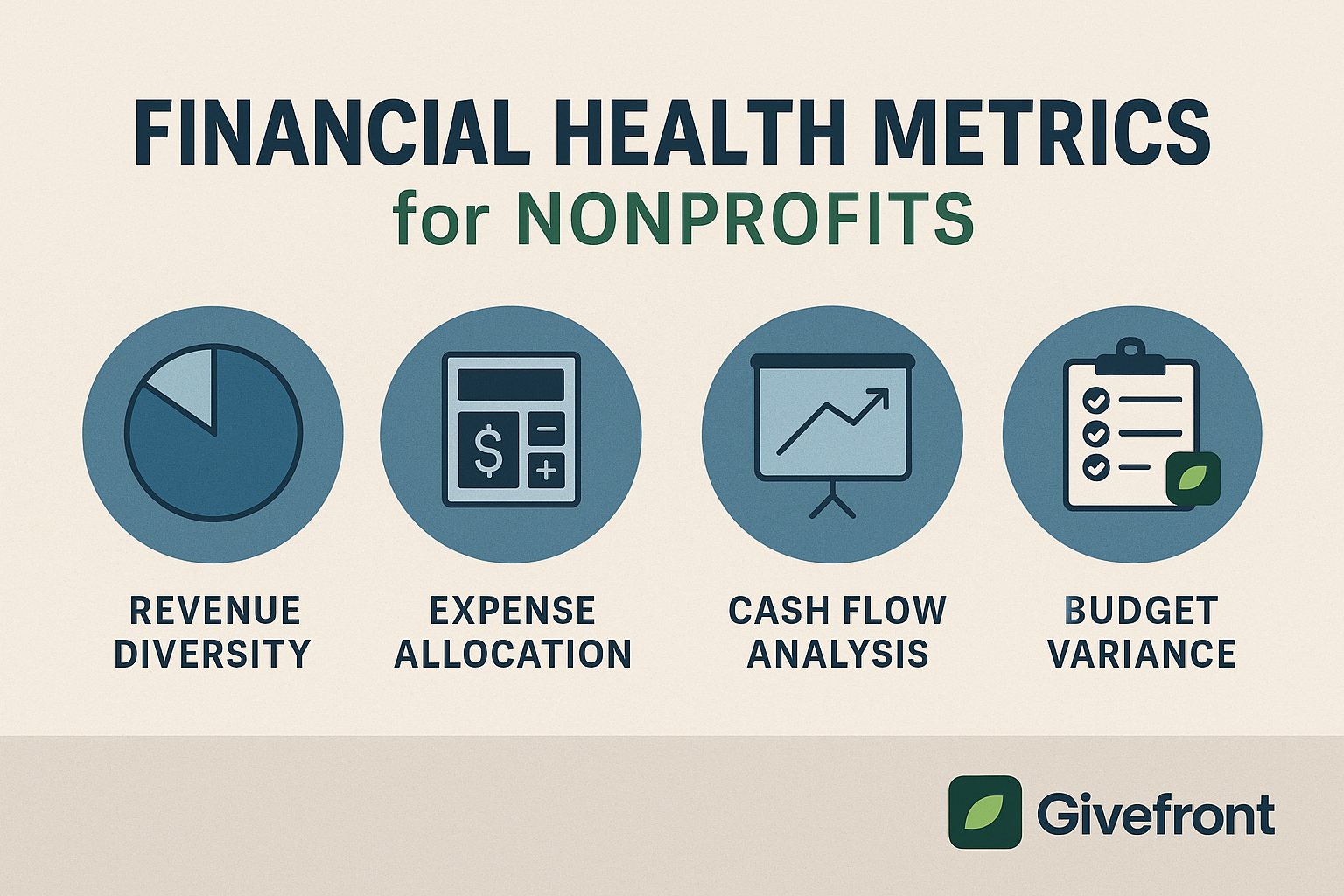How nonprofits can track key financial indicators, reduce risk, and build long-term sustainability.
For nonprofit organizations, strong financial oversight is more than just good governance—it’s critical to mission success. Whether you're feeding families, running after-school programs, or advocating for policy change, your ability to manage resources directly affects how much impact you can make.
But strong intentions don’t guarantee financial stability. That’s why monitoring your organization’s financial health is essential—not just at year-end, but continuously.
What Are Financial Health Metrics?
Financial health metrics are indicators that reflect the fiscal stability, efficiency, and sustainability of your organization. They go beyond basic bookkeeping and provide insight into whether your nonprofit is effectively stewarding its resources, planning for the future, and maintaining the trust of donors, board members, and the public.
Core Metrics to Monitor
1. Revenue Diversity
Overreliance on a single income stream—like one major grant or fundraising event—can leave a nonprofit vulnerable. Diversifying your revenue across donations, grants, earned income, and corporate support strengthens financial resilience and allows greater flexibility in planning.
2. Expense Allocation
Where your money goes speaks volumes about your priorities. Breaking down your expenses by category—program services, administration, and fundraising—helps ensure that the majority of funds are aligned with your mission. It also supports transparent reporting and compliance with funder expectations.
3. Cash Flow Analysis
Cash flow is about timing. Even if your budget is balanced on paper, inadequate cash on hand can interrupt services or delay payroll. Regular monitoring of inflows and outflows ensures your organization maintains enough liquidity to operate smoothly.
4. Budget Variance
Tracking the difference between budgeted and actual results is essential for managing performance. Variances help reveal unexpected shifts—whether positive or negative—so leadership can adjust forecasts, reallocate resources, or intervene early when issues arise.
5. Donor Retention Rate
While acquiring new donors is important, retaining existing supporters is often more cost-effective and indicative of long-term engagement. This metric helps measure the health of your development efforts and the strength of donor relationships.
Tools and Strategies for Monitoring Financial Health
Dashboard Reporting
Modern nonprofits rely on dashboard-style reports to monitor finances in real-time. Dashboards allow leadership and staff to access key financial data at a glance—without waiting for the monthly close. This helps identify trends, spot overspending, and make informed decisions quickly.
Financial Ratios
Several nonprofit-specific financial ratios can help you assess performance:
- Current Ratio: Measures short-term liquidity by comparing current assets to current liabilities.
- Program Efficiency Ratio: Percentage of total expenses spent directly on programs.
- Operating Reserve Ratio: Indicates how many months your organization could operate using unrestricted cash reserves.
These ratios help stakeholders evaluate the organization’s ability to meet commitments, invest in growth, and respond to crises.
Long-Term Financial Planning
Annual budgets are useful, but not sufficient for long-term sustainability. Forecasting future expenses and revenues over multiple years allows organizations to anticipate challenges, plan capital investments, and align resources with strategic goals.
Benefits of Proactively Monitoring Financial Health
Informed Decision-Making
With clear financial insights, leadership can make data-driven choices—whether it’s hiring staff, launching new programs, or navigating a funding shortfall.
Stronger Stakeholder Relationships
Donors, board members, and grantmakers want to see responsible financial management. By reporting on key metrics, nonprofits can demonstrate accountability and build long-term trust.
Improved Risk Management
Early detection of financial strain allows organizations to adjust before a crisis occurs. Whether it’s delayed grant payments, declining donor retention, or overspending on administrative costs, staying vigilant helps mitigate risk.
How Givefront Supports Financial Health Monitoring
At Givefront, we believe that nonprofits deserve purpose-built tools to support their financial operations—not just generic expense software retrofitted for compliance.
Our nonprofit spend management platform gives your team:
- Real-time visibility into expenses and account balances
- Automatic receipt collection via email or text
- Built-in budget tracking by fund, program, or grant
- Custom approval workflows to prevent unauthorized spending
- Export-ready reports for board meetings, audits, and grant reporting
Instead of retroactively fixing financial mistakes, you’ll be able to prevent them altogether—with minimal manual work and maximum clarity.
The Bottom Line
Financial health is not just a back-office concern—it’s a leadership issue. By regularly monitoring key metrics and adopting the right tools, nonprofit leaders can steer their organizations with confidence, adapt to change, and deliver on their missions more effectively.
With Givefront, you gain the structure, visibility, and automation your organization needs to stay compliant, focused, and resilient.
.png)




















.png)
.png)

.png)